Adrian Collins's Blog, page 61
March 28, 2024
REVIEW: Halo Season Two
This is a big improvement. I’m not the kind of guy who gets caught up in trivialities. There’s plenty of people who would only want a Halo TV show if the Master Chief never removed his helmet, and it only depicted a straight ten-episode adaptation of the first video game with most of it being using Needlers on Grunts. I mean, I’d watch the hell out of that, but it doesn’t get into the deeper lore of the Halo universe. Halo does have a pretty deep lore too despite being the Expanded Universe for a bunch of third person shooters. I’ve read dozens of books in the setting, and they mostly hold up.
 Unfortunately, Season One wasn’t good despite the fact it got into things like the recruitment of child soldiers, unethical medical experimentation, the Insurrectionists, and the fact ONI is full of a bunch of incompetent man children. The Halo games were made at the height of the War on Terror and were influenced by the geopolitical situation of the time. There was the seemingly all-powerful Covenant and humanity’s own authoritarian government as the two choices for the setting but Master Chief just trying to save everyone. We’re in a post-War on Terror environment, sort of, and the story is much more muddled in the idea anyone can save anyone. Plus, no one really wanted Master Chief to have sex. Not unless it was a virtual reality simulation with Cortana. Ahem.
Unfortunately, Season One wasn’t good despite the fact it got into things like the recruitment of child soldiers, unethical medical experimentation, the Insurrectionists, and the fact ONI is full of a bunch of incompetent man children. The Halo games were made at the height of the War on Terror and were influenced by the geopolitical situation of the time. There was the seemingly all-powerful Covenant and humanity’s own authoritarian government as the two choices for the setting but Master Chief just trying to save everyone. We’re in a post-War on Terror environment, sort of, and the story is much more muddled in the idea anyone can save anyone. Plus, no one really wanted Master Chief to have sex. Not unless it was a virtual reality simulation with Cortana. Ahem.
Season Two realizes that most viewers want to watch the Master Chief versus aliens and the Covenant finally shows up to start glassing planets. The fact the season opens with the glassing of the planet Madrigal and the elimination of every single plot from that world kind of says what the developers think of it too. Season Two has the Covenant as a threat humanity is on the backfoot fighting and that instantly raises the stakes as well as provides the season some well-deserved focus. Indeed, we finally get the goddamn Halo as a focus for the season with its discovery a central theme. I feel like the fact the Halo WASN’T the focus of a show called Halo until this point as one of the bigger issues of the adaptation. Sort of like The Legend of Zelda without Zelda (or Triforce or Ganon).
The premise for this season is that humanity is being pushed back by the Covenant in every engagement with Master Chief considered unreliable after briefly being possessed by Cortana during their confrontation with the Prophets. Doctor Hasley is under house arrest for her role in the SPARTAN-II insurrection and Admiral Ackerson (Joseph Morgan) is now in charge of the project with Parangosky (Shabana Azmi) seemingly removed from her position as ONI’s chief. Unfortunately, any Halo fan knows this precedes the Fall of Reach where humanity is opened to full-scale invasion by the Covenant. Makee (Charlie Murphy), the human raised by the Covenant, also has some of the keys necessary to find the Halo and has been assigned an Arbiter (not the one from Halo 2) to help find it.
There’s a lot more going on with the season and the show seems more interested in redeeming character’s plotlines than ditching them. Kwan Ha (Yerin Ha), Soren (Bokeem Woodbine), and others are still all in the show, but they are more closely tied together. We also get some casualties among the SPARTAN-IIS that I feel was badly needed to establish the threat of the Covenant after their poor showing in the first season. SPARTANS never die but there’s a reason the Master Chief was the last of them for a long time.
Overall, Season Two is just a huge improvement to the series by incorporating a lot more of what people loved about Halo. Unfortunately, it’s not an unqualified success as the show is still weighed down by cramming too many extraneous plots into eight episodes. The Fall of Reach lasts all of one episode when it could have been three episodes of fighting for survival. Hell, it could have been an entire season. For a show based on an action video game, Halo suffers from not that much action. Still, there is some action and most of it is pretty good. I’ll never look down on Master Chief versus an Elite using plasma swords.
In conclusion, Halo Season Two is a success and I am glad that they listened to fan feedback to modify what they were doing. They also manage to finally get the story to where it probably needed to be by the end of Season One. I’m not going to spoil the ending of the season but a lot of buildup for fan favorite elements are realized and they leave me excited for Season Three. Would I have done things differently? Yes. However, it’s no longer a series that I feel fails to represent the franchise that I love. Halo: Infinite on the other hand…
Watch Halo Season TwoThe post REVIEW: Halo Season Two appeared first on Grimdark Magazine.
March 27, 2024
REVIEW: Necrotown by Alexander Nader
Necrotown by Alexander Nader is a dark urban fantasy noir narrated by Sam Flint, a quasi-immortal private detective living in squalor on the wrong side of Mountain City—not that there’s any right side of Mountain City, a town overrun by drugs, violence, and corruption.
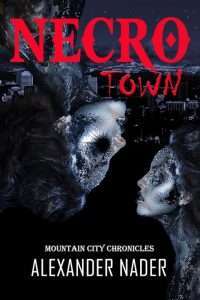 Mountain City is also teeming with monsters, including arms dealing werewolves known as Hairs, usurious Trolls, and several other magical races. The only part of the city where these races coexist is the Glow, the neon-drenched slum that Sam calls home.
Mountain City is also teeming with monsters, including arms dealing werewolves known as Hairs, usurious Trolls, and several other magical races. The only part of the city where these races coexist is the Glow, the neon-drenched slum that Sam calls home.
Sam’s sleuthing partner in Necrotown is his voluptuous wife, the appropriately named Fox, a body-hopping kitsune with a living fox tattoo. The fox tattoo has a name, Sune, and exhibits plenty of personality as it scampers over her body, baring its teeth in anger toward any perceived threat.
As the novel opens, the loving couple are desperate for rent money. They accept a job from Lloyd Burgess, a deep-pocketed sleazebag who instructs them to retrieve his wayward daughter, Sarah, from the notorious Necrotown. Was she kidnapped by gang members? Or perhaps running away from an abusive father? Sarah has more than a few surprises of her own in store for the reader.
Necrotown is the worst section of this godawful city, overrun by death Mages and plenty of necromancy. As a quasi-immortal, Sam himself is not immune from death, and in fact dying is still quite painful. But if he’s lucky, death may be followed by an equally painful resurrection:
“‘This week is gonna suck for you.’ Fox trails a delicate hand across my throat. ‘You are going to die at least six times.’”
The loving and overly flirtatious relationship between Sam and Fox is the highlight of Necrotown, especially as Fox inhabits other beings’ bodies. This keeps their enemies guessing while also providing fuel for Sam’s lowbrow humor.
Alexander Nader’s pulp fiction-style writing superbly conveys the noir vibes of Necrotown, striking a nice balance between humor and horror without ever taking itself too seriously. That being said, the novel would benefit from another round of editing to polish the text and clean up a number of distracting typos. For example, discussion of the five “burrows” of New York City conjures a more leporine image than I believe the author intended.
Nevertheless, Necrotown is an intoxicating read, offering plenty of fun for fans of urban fantasy and noir fiction. The Mountain City Chronicles continues with Vampire Valley, the second book of the series.
Read Necrotown by Alexander NaderThe post REVIEW: Necrotown by Alexander Nader appeared first on Grimdark Magazine.
March 26, 2024
REVIEW: Space Punks 2 by Anna Mocikat
Space Punk 2: Nightingale’s Song is the sequel to Space Punks, which is at least a very accurate title to the story. I’m a huge fan of Anna Mocikat’s Behind Blue Eyes series and really enjoyed the first of this series. If I had to describe it, I’d say it’s close to Cowboy Bebop except hewing closer to cyberpunk motifs instead of Western.
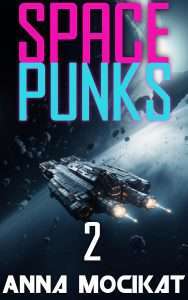 A bunch of sexy cybernetically augmented mercenaries live on the starship Nephilim, doing odd jobs for their mysterious boss, while being involved in both organized crime as well as politics. Most of humanity was exterminated when Earth was destroyed in the wars against the machines, but the survivors live in comparative high tech luxury.
A bunch of sexy cybernetically augmented mercenaries live on the starship Nephilim, doing odd jobs for their mysterious boss, while being involved in both organized crime as well as politics. Most of humanity was exterminated when Earth was destroyed in the wars against the machines, but the survivors live in comparative high tech luxury.
In the previous book, we had the discovery that newcomer David was actually an android that had been sent to infiltrate the crew. We also had Nightingale being horribly injured. This book picks up with giving us David’s origins as well as a follow-up on Nightingale’s condition. Well, it’s not good. If he doesn’t receive a super rare part then he’ll be dead in a week. He also can’t have sex with his girlfriend, Aztec, whom he has just proposed marriage to in a time when that institute is considered to be obsolete.
Much of the book is divided between the protagonists showing their complicated and fascinating relationships, world-building so we understand how this new society works, and the “big heist” where they attempt to hit a military depot in order to get the rare part that Nightingale needs to survive. Say what you will about the Nightingale crew but they are willing to do whatever they have to in order to protect one another.
The best part of the Space Punks series is definitely the cast. All of the characters are interesting with a variety of dark and troubled pasts. They’re a rare sight in science fiction in that most are in committed relationships and deeply devoted to one another while still being no less “cool” and edgy for it. As stated, the crew is intensely loyal to one another and seeing how they can rely on one another makes them easy to root for despite being a bunch of dedicated ruthless cyborg mercenaries.
We get a good look at Mars in this book and find out how he’s gone from being first of Earth’s colonies to the center of human civilization in the setting. Despite being a space-based series, it is very cyberpunk and the Pentad substitutes for the evil megacorporations of most fiction. They are a ruthless oligarchy with control over all of humanity’s vital supplies as well as militaries, so they can do whatever they want without fear from the public. We also get regular tidbits from an in-universe encyclopedia that help fill in the blanks on how the universe functions.
I’m especially fond of Lucien, the villain, who fills all the depraved psychopath folders that make for a good cyberpunk villain. It may be cheating that one of the heads of the cyborg armed forces is also a serial killer but it certainly makes for a delightfully hateable villain. His scenes have genuine menace and you are worried about the protagonists when they are up against him.
In conclusion, Space Punks 2: Nightingale’s Song is an excellent dark and edgy piece of science fiction that would make a good television show with a sufficiently pretty cast. Anne Mocikat is one of my favorite indie writers right now and if you want dark, foreboding, and yet fun adventure fiction then this is definitely for you.
Read Space Punks 2 by Anna MocikatThe post REVIEW: Space Punks 2 by Anna Mocikat appeared first on Grimdark Magazine.
March 25, 2024
REVIEW: Neither Beg Nor Yield by Jason M. Waltz
The definition of Sword & Sorcery is a perennial topic of discussion in related forums. While the unacquainted often use the term to label any variety of fantasy fiction containing edged weapons and magic, fans usually have a very specific style of story in mind: one that hews closer to the blood and thunder-filled stories by Conan creator Robert E. Howard rather than the more genteel work of J.R.R Tolkien. Despite reasonably widespread agreement among enthusiasts of what stories and characters can be categorized as Sword & Sorcery, it becomes surprisingly tricky to nail down what, precisely, differentiates S&S from other varieties of fantasy. Sword & Sorcery stories tend towards grittiness and the horrific, but so do Dark Fantasy and Grimdark. Is a barbarian or thief hero required? Must magic always be treacherous and evil? Must the stakes be personal and localized, or can an S&S story be epic in scope? In his introduction to Neither Beg Nor Yield: Stories with S&S Attitude, editor and Rogue Blades Entertainment proprietor Jason M Waltz sidesteps the endless hair-splitting. He makes a convincing argument that Sword & Sorcery is all about attitude. S&S heroes stubbornly cling to life, no matter how the odds are stacked against them. According to Waltz, “Sword & Sorcery is a clenched fist thrust into the sky, a raised middle finger in the face of the Unknown, an epithet spat into the dirt through a rictus of bared teeth.” At 446 pages in length, Neither Beg Nor Yield brings together 20 stories showcasing this vigorous and defiant attitude. While story quality is uniformly high, in the interest of brevity this review focuses on a subset of stories either expected to appeal to Grimdark fans or those that demonstrate the breadth of the anthology.
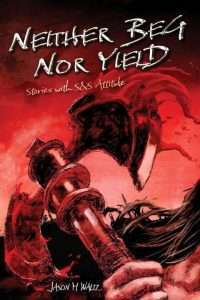 “Prince of Dragons” by William King is one of the outstanding entries of the early portion of te book. King is a prolific contributor to Games Workshop’s Black Library fiction line, and is particularly celebrated for his Gotrek & Felix novels. Here he provides an origin story for his own original hero, Kormak. After massacring his entire village, the infernal Prince of Dragons leaves young Kormak with a promise that some distant day, at a time of the demon’s choosing, the Prince would return to claim Kormak’s life. While Kormak is taken in by the Order of the Dawn and trained in the art of monster-slaying, the Prince of Dragon’s threat is never far from his mind. The story traces several formative episodes in Kormak’s life leading up to his lethal reunion with the demon. “Prince of Dragons” has a compelling sense of grim inevitability throughout, and while I’ve read other Kormak stories by King in the past, this particular story has convinced me that I must investigate further.
“Prince of Dragons” by William King is one of the outstanding entries of the early portion of te book. King is a prolific contributor to Games Workshop’s Black Library fiction line, and is particularly celebrated for his Gotrek & Felix novels. Here he provides an origin story for his own original hero, Kormak. After massacring his entire village, the infernal Prince of Dragons leaves young Kormak with a promise that some distant day, at a time of the demon’s choosing, the Prince would return to claim Kormak’s life. While Kormak is taken in by the Order of the Dawn and trained in the art of monster-slaying, the Prince of Dragon’s threat is never far from his mind. The story traces several formative episodes in Kormak’s life leading up to his lethal reunion with the demon. “Prince of Dragons” has a compelling sense of grim inevitability throughout, and while I’ve read other Kormak stories by King in the past, this particular story has convinced me that I must investigate further.
While many of the stories in Neither Beg Nor Yield stick to familiar Northern or Western European-inspired settings, feudal Japan is used as the backdrop for two contributions. “Hunters and Prey” by C.L. Werner, another popular Black Library writer, is a new tale featuring wandering ronin warrior Shintaro Oba. While Oba frequently appears in issues of Tales from the Magician’s Skull, Waltz notes that the character’s initial introduction was in Rogue Blades’ Rage of the Behemoth anthology. “Hunters and Prey” has Oba on the trail of a diabolical spider demon while Oba is, himself, in turn being stalked by a relentless bounty hunter. Glen Cook (The Black Company, etc.) provides the other samurai-themed entry with “Isekai Sengokumonogatari.” War veteran Shinzutoro finds himself tasked with escorting three orphaned noble children and their guardian through bandit- and monster-infested wilderness. Nearly everyone Shinzutoro encounters on the trail proves threatening, and he senses fairly early on that his travel companions are likewise not what they seem. The Japanese trappings of both stories offer a refreshing change of scenery while still delivering the horror-tinged action expected by Sword & Sorcery fans.
Waltz’s introduction-cum-manifesto argues that attitude is everything when it comes to Sword & Sorcery, so it’s perhaps no surprise that some of the entries in this book reject the conventional tropes of the sub-genre. Set in our era, “Suspension in Silver” by Eric Turowski features a massive biker (a modern-day barbarian?) desperately fighting against a pack of werewolves driven to recruit him. Joe R. Lansdale’s “The Organ Grinder’s Monkey” ranges even further afield, with two mechanics embarking on an inter-dimensional journey (via Chevy) to stop a giant trike-riding monkey’s misguided revenge against the men who killed the monkey’s sloth lover. Neither story is what most readers would typically expect to find in an anthology of this type, but the sort of fierce determination in the face of overwhelming odds lauded in Waltz’s introduction is undeniably present.
“The Last Vandals on Earth” is a gritty historical fantasy by Steven Erikson, of Malazan Book of the Fallen fame. Narrated in the first person by their cook Ulfilas, this story chronicles a small band of misfit Vandals living recklessly for loot and excitement with seemingly the entire world against them. “The Last Vandals on Earth” pairs wry humor with graphic combat as the last Vandals prepare to sell their lives dearly.
A Hanuvar adventure not included in last year’s Lord of a Shattered Land or The City of Marble and Blood, Howard Andrew Jones’ “Reflection From a Tarnished Mirror” was an especially welcome entry. While working to free his Volani countrymen from enslavement at the hands of the oppressive Dervan Empire, fugitive general Hanuvar encounters an impostor masquerading as himself. Further investigation reveals that the man is a soldier with a brain injury that has had Hanuvar’s personality sorcerously overlaid upon his own: an experimental Dervan plot to track the real Hanuvar by creating a mental duplicate that acts and thinks like the original. Deep behind enemy lines, Hanuvar has the delicate task of working with the tragically addled impostor to free the Volani slaves while simultaneously avoiding the scrutiny of the Dervans hunting them both. While nobler in intentions and character than many of the frequently mercenary-minded protagonists in this book, Hanuvar shares their grit and indomitable spirit.
Adrian Cole’s “Maiden Flight” is a truly fitting finale for Neither Beg Nor Yield. Grievously wounded on the battlefield, viking warrior Ulric Wulfsen finds himself chosen for Valhalla by a newly-minted Valkyrie. Ulric and the Valkyrie find themselves at an impasse; Ulric still clings to life and refuses to accept death, while the Valkyrie has no choice but to forcibly escort her unwilling charge to the afterlife or risk being stripped of her divine status and exiled. The struggle between the pair escalates until Ulric finds himself in defiance of Odin himself. While a dogged refusal to capitulate to death is a common hallmark in all of the stories included in this anthology, “Maiden Flight” in particular effectively embodies the “S&S attitude” described by Waltz in his introduction.
Publisher of 15 books over the span of nearly two decades, Rogue Blades Entertainment has been a steadfast supporter of 21st century Sword & Sorcery fiction. Neither Beg Nor Yield is intended to be the final Rogue Blades anthology and the capstone of Jason Waltz’s editing career. Packed with thundering adventure from a wide variety of authors, Neither Beg Nor Yield sends Rogue Blades off on a triumphant note.
Read Neither Beg Nor Yield by Jason M. WaltzThe post REVIEW: Neither Beg Nor Yield by Jason M. Waltz appeared first on Grimdark Magazine.
March 24, 2024
REVIEW: All Who Wander Are Lost by Gemma Amor
Let Gemma Amor be your guide in All Who Wander Are Lost, a new anthology of destination horror stories that lead the reader across adventures on five different continents from northern Norway all the way to Antarctica.
 All Who Wander Are Lost kicks off with “There’s Something in First Landing State Park,” an ill-fated trip to Virginia Beach where the narrator, Melanie, spots a grotesque, slime-covered man emerging from the sand at sunrise, disappearing into the ocean as he oozes a trail of goop behind him. Amor combines science fiction and horror to astonishing effect, taking the story in bizarre directions on her way to a perfectly executed, jaw-dropping conclusion.
All Who Wander Are Lost kicks off with “There’s Something in First Landing State Park,” an ill-fated trip to Virginia Beach where the narrator, Melanie, spots a grotesque, slime-covered man emerging from the sand at sunrise, disappearing into the ocean as he oozes a trail of goop behind him. Amor combines science fiction and horror to astonishing effect, taking the story in bizarre directions on her way to a perfectly executed, jaw-dropping conclusion.
The next story, “The Reunion,” is narrated by Tim, a formerly poor boy who was bullied in school and is now returning to his high school reunion as the successful vice president of a pharmaceutical company accompanied by his beautiful wife. But Tim’s plans of proving his worth to his classmates are disrupted by his ex-wife, Louise, who exacts the ultimate revenge on her former husband for abandoning her and their child. Devoid of supernatural elements, “The Reunion” proves that the most horrific monster may be man himself.
Gemma Amor drops us on a giant glacier in “Fields of Ice,” the third story of All Who Wander Are Lost, which is set in either a near-future dystopian society or some alternate reality. Hayder, an explorer working for an autocratic leader known as the Minister, is sent on a special mission in pursuit of precious ore, but perhaps she is the one being pursued.
The following story, “Let Sleeping Gods Lie,” delivers an Indiana Jones-style adventure as we join an archaeological expedition in Egypt. Written in epistolary format, Gemma Amor takes us on a haunting journey through an underground labyrinth, showing that some ancient powers should be left undisturbed.
Amor channels Daphne du Maurier’s “Don’t Look Now” in her Venetian horror, “The Final Wish Foundation,” bringing several thrilling twists to this familiar backdrop to horror. Next up is “A Song for Sam,” in which two brothers travel to Norway to fulfill their late father’s wish to scatter his ashes beneath the aurora borealis, but one brother has a more sinister plan in mind.
The remaining stories in All Who Wander Are Lost include “The Ancient Ram Inn,” a classic haunted house horror turned inside out, “A Gentlewoman Abroad” about a businesswoman who despises tourists to an unhealthy degree, and “Less Exalted Tastes” about a rather sadistic form of artistry. The anthology concludes with “Christmas in Antarctica,” a decidedly chilling supernatural horror that will make you want to stay at home for the holidays.
Altogether, All Who Wander Are Lost is a masterfully conceived and executed anthology that serves as Gemma Amor’s homage to the human desire to travel and explore. I enjoyed the variety of styles that Amor brings to the concept of destination horror across this anthology.
Read All Who Wander Are Lost by Gemma AmorThe post REVIEW: All Who Wander Are Lost by Gemma Amor appeared first on Grimdark Magazine.
Grimdark Magazine Issue 38 to feature the best of South East Asia SFF
Last Updated on March 25, 2024
We have two announcements for the upcoming release of Grimdark Magazine Issue 38. As somebody who lives in the Asia Pacific, the first announcement I think is one of the ones I’m the most excited about in my almost ten years of running this little publication. The second one is one of those announcements I dislike making. Let’s get to it.
GdM#38 to focus on SEA authorsNearly nine percent of the world’s population live in South East Asia. A lot of history, mythology, stories, and world views sit in those nations and their peoples, and we feel that often the English speaking markets miss out on those stories for a range of reasons. Books like Sons of Darkness by Gaurav Mohanty have joined the list of authors giving us a lens into non-Euro grimdark fantasy, and I think the opportunity to really push the boundaries of our little corner of the subgenre world lies in giving authors from SEA a spot to play about with their characters and ideas in short form. For this issue, our contributors will be:
The contributor lineupR.R. VirdiGourav MohantyYudhanjaya WijeratneVajra ChandrasGautam BhatiaekeraLavanya LakshminarayanAaron S. JonesAlex ValdiersWe also have a few people yet to sign off on their inclusion, whose names we will be releasing when we do the cover release (a snippet of which you’ll find in the header of this post!).
GdM#38 to be published on the 15th of AprilNow, to the part that we never like to announce: we’ve had to push back our publication schedule by a fortnight to make sure we got all the content we needed. As it is with small groups of people trying to build things, sometimes life gets on top, and in this instance, it got on top of a few of us and we weren’t able to meet our commitment to you.
Rest assured, however, this will be worth the wait.
The post Grimdark Magazine Issue 38 to feature the best of South East Asia SFF appeared first on Grimdark Magazine.
March 23, 2024
REVIEW: Dreams of Fire by Shauna Lawless
Shauna Lawless already sits pretty high on my auto-buy author list based on her first two novels, The Children of Gods and Fighting Men and The Words of Kings and Prophets. So I was extremely excited to learn that Lawless was returning to her Middle Ages Irish historical fantasy Gael Song series with her novella Dreams of Fire. Let me tell you: I pressed that pre-order link as soon as it appeared on my newsfeed. I love Shauna Lawlewss’ writing and I love novellas. It was going to make a great reading day. And it did.
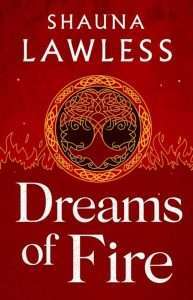 Even if you have yet to read the other novels in the Gael Song series, you can start with Dreams of Fire as a bit of an amuse-bouche and enjoy it with no other knowledge. The events in Dreams of Fire take place about a century before the first novel, so it is the perfect introduction if you are still unsure if this series will be for you. If, like me, you have read and loved the other novels, this novella allows you to see these beloved characters from a different perspective and learn more about my favourite character, Rónnat.
Even if you have yet to read the other novels in the Gael Song series, you can start with Dreams of Fire as a bit of an amuse-bouche and enjoy it with no other knowledge. The events in Dreams of Fire take place about a century before the first novel, so it is the perfect introduction if you are still unsure if this series will be for you. If, like me, you have read and loved the other novels, this novella allows you to see these beloved characters from a different perspective and learn more about my favourite character, Rónnat.
Rónnat is the sister to Fódla, one of the main characters from The Children of Gods and Fighting Men and The Words of Kings and Prophets. They are Descendants of the Tuatha Dé Danann, and their peaceful life with their father is threatened. Rumors are that all the Descendants must move to their hidden fortress for protection from mortal men and their sworn enemies, the fire-wielding Formorians. Rónnat feels trapped in the fortress, surrounded by people, with no space to roam or find solitude. Worse, her arrival there triggers a strange voice whispering to her of death and destruction and disturbing dreams full of fire.
Shauna Lawless is a brilliant writer, even in a shorter piece of fiction that shines through. Dreams of Fire is just over a hundred pages, but it is still an utterly immersive novella, and in that short time, Lawless makes you genuinely care for the characters. You feel the sisterhood between Rónnat and Fódla, their hopes, their fears. I accept that I already know the characters and the wider plot, but even if I did not, I genuinely believe it would evoke the same response. Lawless blends Irish mythology and history perfectly, and Dreams of Fire is reading time that is very well spent.
I want to say a huge thank you to Shauna Lawless and the team at Head of Zeus for sending me an eARC of Dreams of Fire. Also, thank you to fellow GdM Team Member John Mauro for arranging it with Shauna! Although I was sent an eARC in exchange for providing this review, I also bought the novella, which is available now as an e-book for the princely sum of 99p or $1.99, depending on your area. The third novel in Lawless’ Gael Song series, The Land of the Living and the Dead, is scheduled for release by Head of Zeus in September 2024.
Read Dreams of Fire by Shauna LawlessThe post REVIEW: Dreams of Fire by Shauna Lawless appeared first on Grimdark Magazine.
March 22, 2024
REVIEW: System Collapse by Martha Wells
Last Updated on March 23, 2024
The seventh instalment in The Murderbot Diaries by Martha Wells, System Collapse follows on closely from Network Effect (book five, and previously the series’ only novel-length story) with another hugely entertaining blast of rogue SecUnit action, snark and uncomfortable emotions. After the events of Network Effect (we’ll leave it at that for anyone who hasn’t read it), Murderbot is spending its time safeguarding colonists from ruthless Barish-Estranza corporates and their shady ‘contract’ offers. The problem is, Murderbot’s recent traumatic experiences have resulted in a noticeable drop in performance, which isn’t ideal…especially considering Barish-Estranza have their own SecUnits and aren’t afraid to play dirty.
 There’s a lot to keep track of here, with various new characters alongside quite a few jumps around the series’ timeline (a reread of Network Effect, or at least the last few chapters, is definitely advised), but overall System Collapse feels rich and rewarding, offering real development for both Murderbot as a character and The Murderbot Diaries as a whole. A consistent theme throughout the series involves Murderbot – no longer a slave to its corporate ‘owners’ – wrestling with the complexities of free will. System Collapse continues with this, but also digs into the complexities involved in coming to terms with and learning to cope with trauma.
There’s a lot to keep track of here, with various new characters alongside quite a few jumps around the series’ timeline (a reread of Network Effect, or at least the last few chapters, is definitely advised), but overall System Collapse feels rich and rewarding, offering real development for both Murderbot as a character and The Murderbot Diaries as a whole. A consistent theme throughout the series involves Murderbot – no longer a slave to its corporate ‘owners’ – wrestling with the complexities of free will. System Collapse continues with this, but also digs into the complexities involved in coming to terms with and learning to cope with trauma.
Seven books in, it would be easy for Wells to simply give readers more of the same – more action, more snark, more Sanctuary Moon, more Murderbot-staring-at-a-wall – in another straightforward, standalone adventure. Instead, rather than taking the easy option Wells has opted for a slightly different feel to most of the other stories. This is a little slower and a little less action-packed, a more introspective story that shows Murderbot at its most vulnerable – physically and emotionally – and forces it into a situation that needs more than strength and speed to resolve. Don’t worry, Murderbot still does its fair share of fighting, but it has to learn to deal with people and events in different ways too, uncomfortable though that may be.
Billed as a ‘full-length novel’, really this is more of a short novel, falling in between the usual novella length and the heft of Network Effect, and somehow it feels like the best of both worlds. Despite the relative lack of action it feels every bit as tight and snappy as the novellas, just with a little more room to breathe. All told it’s another excellent story in its own right, providing yet more evidence that Murderbot is – despite being an artificially-created killing machine – one of the most relatable (not to mention entertainingly badass) characters in modern science fiction. The Murderbot Diaries might not be overtly grimdark, but it’s a series that’s likely to have a lot of crossover appeal, and System Collapse only reinforces the fact that Murderbot really should be on every SF fan’s reading list.
A version of this review first appeared on trackofwords.com
Read System Collapse by Martha Wells Read on Amazon
Read on AmazonThe post REVIEW: System Collapse by Martha Wells appeared first on Grimdark Magazine.
March 21, 2024
REVIEW: The Thick and the Lean by Chana Porter
Chana Porter’s The Thick and the Lean is one of those rare stories that continue living in your brain rent-free long after the last page. This is slow, delicious literary SFF, a story about a looming presence and social pressure. If you’re looking for epic events, battles or action, this is not the book for you. To use the book’s food focus, this is small plate haute cuisine. You need to be in the mood for it, not looking for a quick burger fix. That said, The Thick and the Lean is utterly delicious, a story to savour.
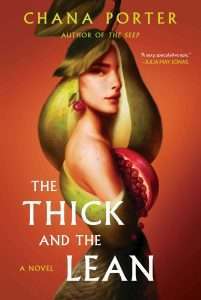 Beatrice is obsessed with food. It’s the thing she dreams about – but she has been raised in Seagate, a cult-like community where food has mostly been replaced by supplements. To be seen eating is shameful. Reiko is a poor university student, set to make her own future. Soon, her scholarship is taken away, however, leaving her unable to stay in school without going into ruinous debt. Both women need to figure out how to move forward in life, how to untangle their own desires from social customs. A shared story weaves through the book, providing touching points for the two plotlines.
Beatrice is obsessed with food. It’s the thing she dreams about – but she has been raised in Seagate, a cult-like community where food has mostly been replaced by supplements. To be seen eating is shameful. Reiko is a poor university student, set to make her own future. Soon, her scholarship is taken away, however, leaving her unable to stay in school without going into ruinous debt. Both women need to figure out how to move forward in life, how to untangle their own desires from social customs. A shared story weaves through the book, providing touching points for the two plotlines.
The most grimdark character in the story is society at large. The characters themselves are complex and multi-layered, of course, but the looming sense of unease, of struggling against perceived boundaries is what makes The Thick and the Lean. In many ways, it doesn’t matter who the story is about specifically, it matters far more to see these characters as examples of the society they move in. The narration, with its poetic prose, helps create that sense of distance, following Beatrice and Reiko closely without ever really taking us into their minds. In that sense, The Thick and the Lean is closer to literary fiction than what we tend to expect of genre fiction.
Within a few pages I found myself fascinated by the story, the challenges the characters face – and the relationship they have to food. For me, as someone who has a complicated relationship with food due to chronic illness affected by it, it rang true in so many ways. Who are we without food, who does eating make us? The Thick and the Lean doesn’t provide the reader with easy answers. Rather, it poses questions, questions that make us ponder who we are and how we interact with the world. There is a clear anti-capitalist sentiment to The Thick and the Lean – I particularly liked how it homed in on consumer culture and voyeurism. Oh, and its set in a queernormative world, using acceptance of queerness as a means to show other inequalities in society.
The contrasting perspectives of Beatrice and Reiko helped show the range of issues their society faces, highlighting how being yourself is a much harder road than following along the masses. Through religion, cult-like devotion to corporations, expectations of sexual submission for women, along with the core themes of food, eating and shame, The Thick and the Lean makes a powerful statement that it is worth it to stand up for yourself and what you believe. Tender and brutal at the same time, I am certain I’ll keep thinking about this for a long time.
Read The Thick and the Lean by Chana PorterThe post REVIEW: The Thick and the Lean by Chana Porter appeared first on Grimdark Magazine.
March 20, 2024
REVIEW: Mushroom Blues by Adrian M. Gibson
Last Updated on March 21, 2024
Adrian M. Gibson completely breaks the mold of conventional storytelling in Mushroom Blues, a wonderfully weird, darkly disturbing and freakishly fungal sci-fantasy noir debut that is more dangerously addictive than any drug imaginable.
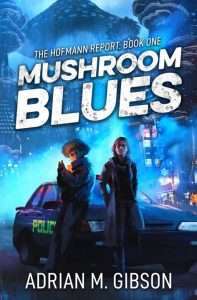 In many ways, the start of this novel reminded me of the start to Krystle Matar’s Legacy of the Brightwash, except make it a lot more fungal. Both stories open with a curmudgeonly, angry, and deeply flawed officer of the law making the horrifying discovery of a young child’s mutilated body, which then sucks them into a chaotic murder investigation that ends up challenging them not only physically, but especially on a mental, moral, emotional, and spiritual level.
In many ways, the start of this novel reminded me of the start to Krystle Matar’s Legacy of the Brightwash, except make it a lot more fungal. Both stories open with a curmudgeonly, angry, and deeply flawed officer of the law making the horrifying discovery of a young child’s mutilated body, which then sucks them into a chaotic murder investigation that ends up challenging them not only physically, but especially on a mental, moral, emotional, and spiritual level.
From the very first page, Hofmann’s intimate first person narration completely sucked me in, and I quickly started rooting for her while also being horrified by her racist and prejudiced beliefs and worldviews. I am almost ashamed to admit that I initially found myself getting slightly infected by her revulsion of all things fungal, which just goes to show how incredibly strong and effective Gibson’s character work is.
Though her biased view of the mushroom people and their culture is exactly what made her such a complex and compelling protagonist, and I loved experiencing the fantastically fungal city of Neo Kinoko through her outsider’s perspective. As her worldviews started to be challenged by her first-hand experiences, I soon found myself utterly fascinated with the hidden beauty of the fungal people’s way of life.
Gibson simply establishes this vibrant and immersive world with masterful talent, breathing so much life into the city and its people, while also dropping in just enough spores (pun indeed intended) to make the wider world feel tangible and unfold in the most organic way possible. Moreover, I really enjoyed the Japanese influences in the creation of Neo Kinoko, as those more familiar aspects actually helped ground me amidst all the bewildering fungal world building going on in Mushroom Blues.
There’s so much richness and authenticity to the culture of the fungal people, from the language, to the food, to the religion, and to all the uniquely quirky customs and beliefs. And don’t get me started on their interesting sense of community and way of communication through the fungal network, which just has to be one of the most imaginative takes on a soft magic system I have ever come across.
Though, what I appreciated most about the establishment of this group of people, is the fact that they are not presented as a monolith. Through Hofmann’s interactions with all kinds of different fungal people, the staggering nuance and complexity of their community really starts to shine through. I was personally especially surprised by the beautifully complex dynamic that developed between Hofmann and her reluctantly assigned partner, the fungal cop Koji (who needs to be protected at all costs, thank you very much).
It is just truly beyond me how Gibson managed to tell a story that is so utterly alien, yet tragically and beautifully human at the same time. On top of the broader themes of colonisation, corruption, sexism, and oppression, Mushroom Blues also tackles much more intimately vulnerable topics of grief, regret, trauma, motherhood, forgiveness, redemption, and healing. Yet at no point does the tone of the story ever become preachy, as these themes are all masterfully woven into Hofmann’s tumultuous character arc that we get to experience from the front-row seat.
Now, there’s no denying that Mushroom Blues is a confronting and uncomfortable reading experience at times, but at the same time it also has an addictively high entertainment factor. By using all the best tropes and the tight plotting of the crime detective genre, Gibson is able to maintain an intoxicating air of mystery while this story throttles along at full speed. An entertaining buddy cop dynamic, believably depraved baddies who you can love to hate, thrilling car chases, confounding murder boards, dangerous gunfights, tense interrogations, and, of course, some psychedelic madness; Mushroom Blues has got it all.
There were maybe a few moments where some revelations or shifts in attitude felt a tiny bit rushed, especially when characters reminded themselves of the fact that all these crazy events had taken place over a mere couple of days. That said, the way that all the seemingly separate elements and threads of the story ultimately interweave is nothing short of masterful, resulting in an anxiety-inducing climax sequence that hits all the right emotional beats and just hurts so damn good.
Safe to say, I have been infected with the mushroom madness, and I am now hungering for more in the best way possible. This story blew all my expectations completely out of the water, and how Gibson thought it was acceptable to write a debut of this insanely high quality will forever be the true mystery to me.
If you like the sound of a dark, fast-paced, and highly imaginative fungalpunk noir story that will take you on a brutally wild emotional rollercoaster, then don’t hesitate to enter the Fungalverse and pick up Mushroom Blues now!
Thank you to the author for providing me with an eARC in exchange for an honest review. All opinions are my own.
Read Mushroom Blues by Adrian M. GibsonThe post REVIEW: Mushroom Blues by Adrian M. Gibson appeared first on Grimdark Magazine.

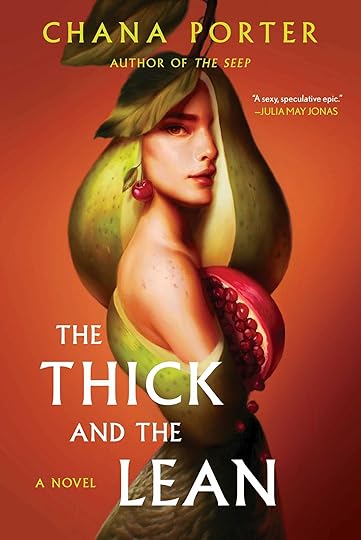 Read on Amazon
Read on Amazon

